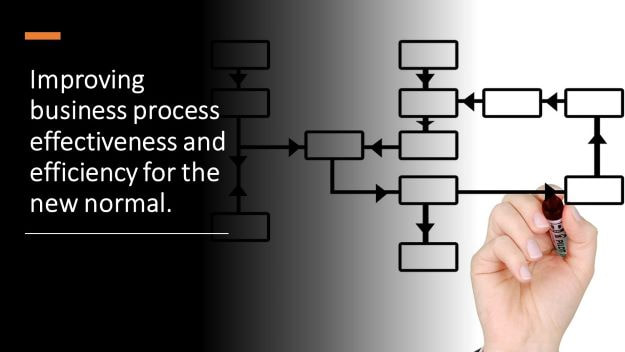This necessitates that businesses today become more malleable to deal with long-standing turbulence. And that can only happen with continuous improvement of business processes and implementation of solid risk management strategies. I shall discuss Continuous Improvement aspect here …
Continuous Improvement of business processes make them both Efficient and Effective. And, these Efficient and Effective processes result in increased customer satisfaction, market share, top line, and bottom line. |
For organizations which didn’t begin Continuous Improvement while they were start-ups, must begin ASAP. And for all businesses which are struggling to survive either because of the pandemic or otherwise, must initiate Continuous Improvement campaign immediately.
It is not always essential for organizations to undergo a complete make-over since continuous improvement can also be done in increments.
If your organization is small or low on budget front, no worries, simply start with Kaizen.
I’ve separate posts on Kaizen which you may want to check out here. However, I shall briefly introduce Kaizen here-
Kaizen is a Japanese technique of continual improvement. Kaizen involves making small incremental changes to business processes to improve them continually, to bring about exponential rewards. And the best part is that Kaizen can be applied to all industry sectors including manufacturing, service etc. Also, Kaizen can be applied effectively in both non-regulated and regulated industries.
In fact, Kaizen-ing had got most of Japanese companies out of a messed-up economy post world war II. Therefore, Kaizen is a proven business improvement methodology. Having said that, do make sure you’re tweaking Kaizen to suit today’s business environment, especially your organizational culture.
Industry 4.0 involves digitization, automation, robotics, artificial intelligence, remote working etc. Kaizen can be superbly adapted to present day’s work and working norms. Know more about how Kaizen can help your company here.
Combining Kaizen with yet another Continuous Improvement methodology- Lean, has been found to bring-in larger and faster returns.
Overall there are more than eighteen scientific, structured, and time-tested Continuous Improvement methodologies. Pick any one or a combination of methodologies that can bring best rewards for your organization.
Continuous Improvement Strategy:
It’s said, “Every journey begins with the first step”… and the first step in the Continuous Improvement journey is to acknowledge whether your business processes are or aren’t Effective … since, if the problem isn’t identified, all solutions are bad!
Lack of business process effectiveness is usually exhibited by low employee motivation, high employee turnover, defective products/ services, product recalls/ returns and customer-complaints. While poor business process efficiency is exhibited by high overheads as well as wastage of time, money and other resources.
The first step of initiating Continuous Improvement in an organization is to build a robust Process Improvement strategy and execution plan. This strategy must be broad and encompass all aspects of the organization’s operations, products, finance, competitors, employees and customers that impact the company’s survival and growth.
This broad strategy must then be sub-divided into sub-strategies with an aim to modify or re-design each underlying business process to make them Efficient and Effective.
Steps to install Continuous Improvement:
Once root cause(s) of the problem(s) are known, then go ahead with modification or re-design of the process(es) to get rid of the problem(s). Once the problems are ridden, the new process must be backed up by appropriate resources.
Another vital point while improving business process effectiveness and efficiency is to find out- What the customer wants and whether the company has its focus on those wants.
Note that implementing new business processes can be a large step and may require special change management models to facilitate bringing-on change. In addition, employees must be educated on the reasons behind new (modified) business processes that are being implemented to ensure that the process effectiveness rises high.
Therefore, create an environment which fosters employee-engagement. Employees in all departments need to be able to communicate freely and to be heard on various topics, such as their ideas regarding inadequacies or areas that are lacking within the organization. It is vital to take employee suggestions, especially from those most close to the process.
Alongside Continuous Improvement campaign, a successful way to increase business process effectiveness and efficiency is to add greater focus on daily business activities and figure out how they can be made more profitable.
After all steps of Continuous Improvement installation are complete, it is vital to review the changes and continue to use the modified business process to sustain both process effectiveness and efficiency.
Note that, even if a good Continuous Improvement strategy is developed, it does not mean much unless it is applied effectively.
Correctly designed Process Improvement strategy results in Efficient Processes, while apt implementation of the strategy makes Processes Effective. |
In conclusion, note that, all Continuous Improvement methodologies must be tweaked to include evolutionary customer demands, organization's culture and workplace changes such as- digitization, automation, robotics, artificial intelligence, remote working etc. and adapted to present day’s work and working norms.
Planning on initiating Continuous Improvement campaign at your workplace?
#ContinuousImprovement #Kaizen #Lean #BusinessProcessEffectiveness #BusinessProcessEfficiency #ContinousImprovementStrategy #NewNormal #Covid19 #BusinessProcessImprovement #ProcessDesign





















